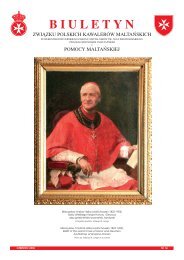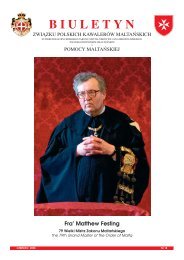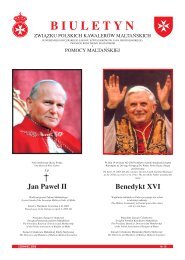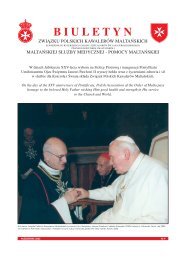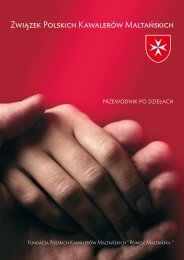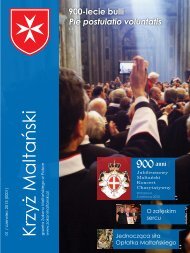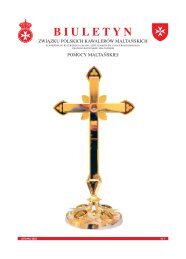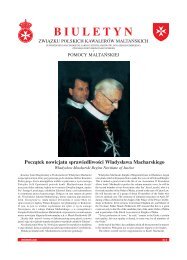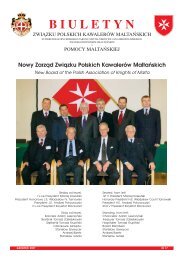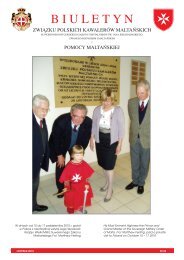Nr.11 - Zakon Maltański Polska
Nr.11 - Zakon Maltański Polska
Nr.11 - Zakon Maltański Polska
You also want an ePaper? Increase the reach of your titles
YUMPU automatically turns print PDFs into web optimized ePapers that Google loves.
HistoriaHistoryudało się zabrać; między pozostałymi w łóżkach chorymi Niem−cy ustawili granatniki i rozpoczęli ostrzeliwanie powstańców 4 .Pod eskortą Niemców pochód rannych pomaszerował przezPlac Bankowy, ul. Przechodnią, Plac Żelaznej Bramy, Ogród Saskido barykady blokującej ul. Marszałkowską. Po drodze tak cho−rzy, jak i lekarze byli zaczepiani przez Własowców, którzy za−bierali im cenne drobiazgi.Walki sprawiały, że Szpital musiał dość często zmieniać miej−sce działania. Ostatecznie, nocą z 5 na 6 września, zajął budynekprzy ul Śniadeckich 17 i tam funkcjonował aż do upadku Po−wstania. Po kapitulacji, jako jedyny szpital warszawski, Szpital<strong>Maltański</strong> został w całości ewakuowany do Piastowa i ulokowa−ny w fabryce „Tudor”.LIKWIDACJAPo zakończeniu wojny Szpital <strong>Maltański</strong> podlegał Polskie−mu Czerwonemu Krzyżowi i od dnia 23 marca 1945 roku działałjako pomocniczy szpital garnizonowy w Częstochowie. Wtedyteż przyjął nową nazwę „Szpital <strong>Maltański</strong> Czerwonego Krzy−ża”. W 1949 roku władze komunistyczne ostatecznie zlikwido−wały tę zasłużoną placówkę, a jej majątek i wyposażenie przeka−zały częstochowskiej służbie zdrowia.Pomimo likwidacji pamięć o Szpitalu <strong>Maltański</strong>m przetrwa−ła wśród mieszkańców Warszawy, byłych rannych niemieckichi polskiej emigracji. Magdalena Lipkowska wydała książkę o jegobohaterskiej epopei, a w 50−tą rocznicę jego powstania na daw−nym gmachu Resursy umieszczono pamiątkową tablicę z mal−tańskim krzyżem i prostym napisem „Tu działał wojskowy Szpi−tal <strong>Maltański</strong>”.Artykuł ten jest bardzo niepełnym i fragmentarycznym zary−sem dziejów Szpitala <strong>Maltański</strong>ego. Autor zadaje sobie z tegosprawę i przeprasza osoby których nazwiska, lub nazwiska ichbliskich, nie zostały wspomniane.1Maria Maciejewska Rucińska − Wojskowy Szpital <strong>Maltański</strong>. Szpital AK−s.l. s.a.2Ibidem, str. 223Odebrane rodzicom dzieci z terenów zamojszczyzny i ze względu na swój wyglądprzeznaczone do adopcji przez rodziny niemieckie i germanizacji.4dr J. Dreyza, Szpital <strong>Maltański</strong> przy ulicy Senatorskiej w czasie PowstaniaWarszawskiego [w:] Archiwum Historii Medycyny 1968, XXXI, 2, str. 265−70FINAL CLOSINGAfter the war, the Maltese Hospital came under the jurisdictionof the Polish Red Cross, and from March 23 rd 1945 it acted as theauxiliary military hospital in Częstochowa. At that time it adopteda new name, “Maltese Hospital of the Red Cross.” In 1949, theCommunist authorities finally abolished this heroic institution,transferring its assets and equipment to the public medical servicesof Częstochowa.Despite the abolishment, the memory of the Maltese Hospitalremained alive among the inhabitants of Warsaw, the formerGerman wounded, and the Polish émigré community abroad.Magdalena Lipkowska is writing a book about its heroic history,and on the 50 th anniversary of its establishment, a memorial plaquewas mounted on the Resursa building, carrying the Maltese Crossand a simple inscription: “Here stood the military MalteseHospital.”This article is a very incomplete and fragmentary outline ofthe history of the Maltese Hospital. The author realizes this, andbegs the forgiveness of persons whose names, or the names oftheir loved ones, were not mentioned.1Maria Maciejewska Rucińska, Wojskowy Szpital <strong>Maltański</strong>. Szpital AK. n.p.,n.d.2Ibid., pg. 223Action at the Arsenal, March 26, 1943, was an attack by AK units to rescue agroup of prisoners being moved by the Germans from Gestapo headquarters toPawiak prison. The action succeeded in freeing 21 of 25 prisoners.4SS General Franz Kutschera was a high Nazi official in occupied Warsaw, andchief of SS Police from October 1943. He was particularly barbaric, putting intoeffect mass executions which took the lives of about 4,300 persons. A court of thePolish Underground State issued a death sentence on him, and he was killed in araid by the AK on February 1, 1044. After his death, the Germans suspendedmass executions.5On August 12, 1943, a successful AK raid on a bank netted over 100 millionzlotys, intended to finance the operations of the AK Head Command.6A raid on September 26, 2943, on German police and military posts in the Wilanówsection of Warsaw, and on “Volksdeutch” collaborators (Polish residents of German descent who accepted German citizenship from the Nazis) in retaliation forinforming on AK units training in the nearby forests.7Children taken from their parents in the Zamość Region, intended because oftheir appearance for the “Liebensborn” program, i.e. Germanization throughadoption by German families.8Dr. J. Dreyza, “The Maltese Hospital on Senatorska Street during the WarsawUprising” in Archiwum Historii Medycny [Archives of history of medicine] 1968,XXXI, 2, p. 265−270Życie duchoweSpiritual lifeWIĘCEJ O ŚWIĘTACH BOŻEGO NARODZENIAMore About ChristmasKs. Mirosław NowosielskiŚwięto Bożego Narodzenia, które co roku obchodzimy,kojarzy nam się zwykle z choinką, wigilią, różnymi tradycjamirodzinnymi, dla rodziców zaś, a zwłaszcza dla kobiet – z trudamiprzygotowań do świąt. Tymczasem wiele cennych treści, jakieniosą te święta zostaje niezauważonych i nie wykorzystanychdla głębszego doświadczenia rozwoju duchowego. Są nimi znaki,jakie pojawiają się w Boże Narodzenie, a których treści rodzicemogą wykorzystać we wspaniałej „domowej” katechezie.W niniejszym artykule pragnę trochę pomóc rodzicom (i nietylko rodzicom), jak można lepiej przeżywać święta BożegoNarodzenia. Zacznijmy krótko od historii. Kiedy zaczętoobchodzić święta Bożego Narodzenia?The feast of Christmas, which we celebrate every year, weassociate with the Christmas tree, the Wigilia dinner, variousfamily traditions; for the parents, and especially for women, withthe hard work of preparing for the holidays. But much of thevaluable context of this feast remains unnoticed and unexploitedfor deeper spiritual development. There are symbols that can beseen at Christmas, which parents can use in religious educationin the home. In this article I aim to assist parents (and not onlyparents) in transmitting the message of Christmas.Let us start with some history. When was Christmas firstobserved? While the Easter Triduum was observed from the dawnof Christianity, Christmas was introduced at the beginning of theStrona 10 LISTOPAD 2004



